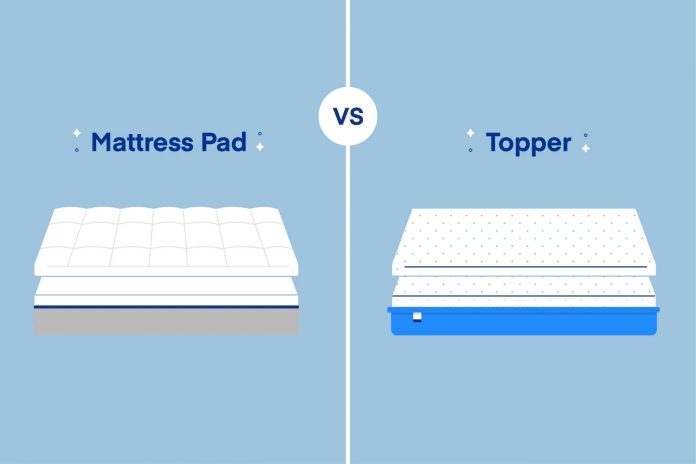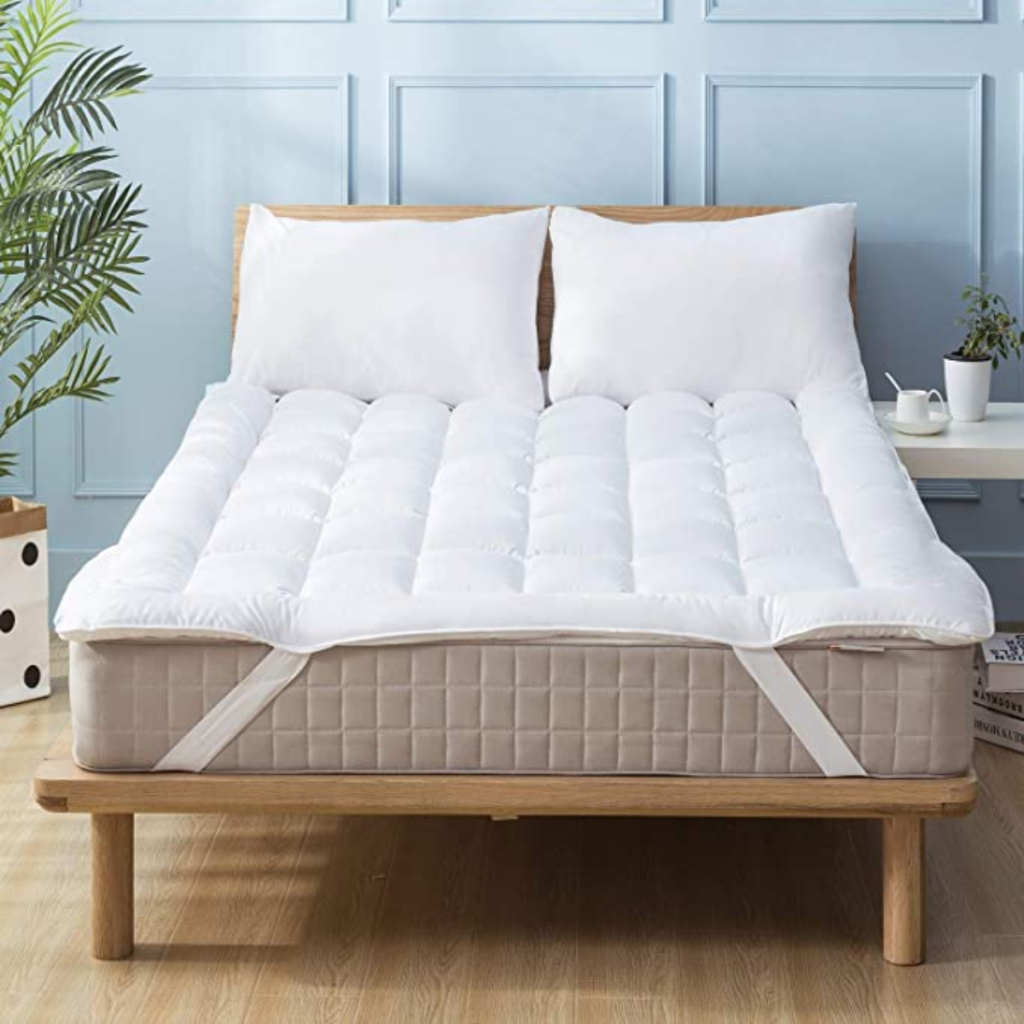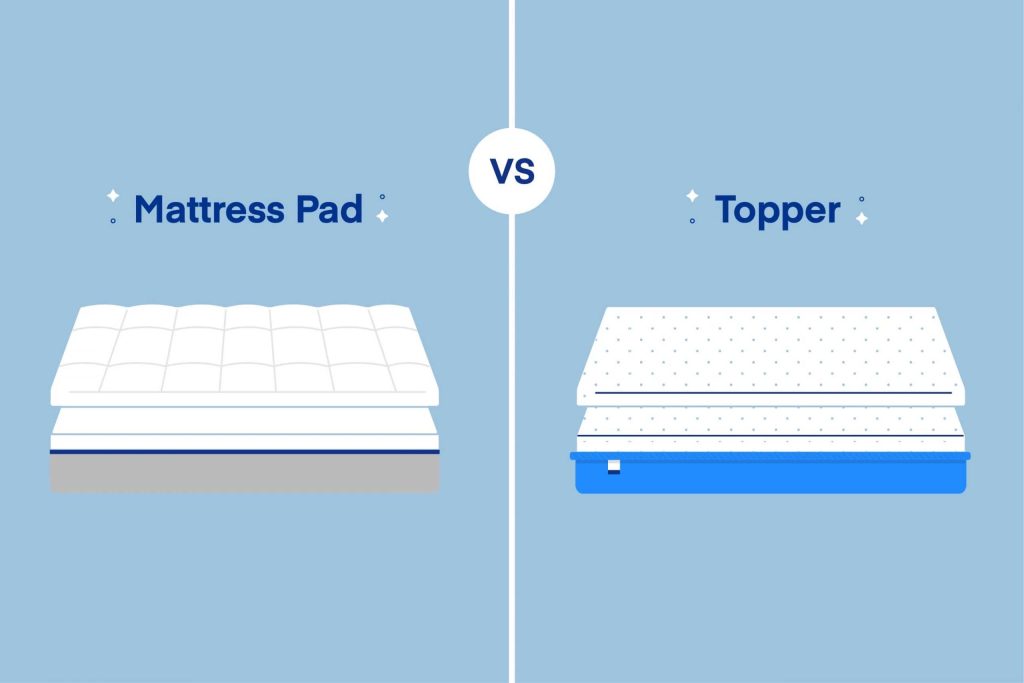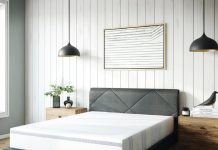You’re not alone if you’ve ever wondered how mattress pads work their magic. We’ve all experienced those frustrating spills, stains, and accidents that threaten to ruin our precious mattresses.
But fear not because mattress pads are here to save the day! These ingenious creations act as a barrier between you and your mattress, guarding against spills, dust mites, allergens, and even wear and tear.
So, kick back, relax, and let us take you on a journey of discovery as we unravel the secrets behind mattress pad protection.
Review contents
What is a Mattress Pad?
A mattress pad is a bedding accessory placed on top of a mattress to provide various benefits such as protection, comfort, and hygiene. It is typically made of an extra cushioning material and is designed to fit securely over the mattress. Mattress pads come in various sizes, materials, and thicknesses to cater to different needs and preferences.
Materials Used
Mattress pads are available in various materials, each offering different comfort levels and functionality. Some commonly used materials include:
- Cotton: Cotton mattress pads are known for their breathability and softness. They provide a comfortable and relaxed sleeping surface, making them ideal for hot sleepers.
- Polyester: Polyester mattress pads are more affordable and durable compared to cotton. They are hypoallergenic and resistant to stains, making them a practical choice for those with allergies.
- Memory Foam: Memory foam mattress pads offer superior cushioning and pressure relief. They conform to the body’s shape, providing optimal comfort and support.
- Waterproof Materials: Some mattress pads use waterproof materials such as vinyl or polyurethane. These materials provide an added layer of protection against spills, stains, and liquid damage.
Choosing a mattress pad made from high-quality materials ensures durability and long-lasting performance.
Benefits of Using a Mattress Pad
Using a mattress pad offers several benefits, enhancing your mattress’s comfort and longevity. Let’s explore some of these benefits in detail.
1. Protection against stains and spills
One of the primary functions of a mattress pad is to shield your mattress from stains and spills. Accidents happen, whether a spilled glass of wine or a child’s bedwetting incident. A mattress pad acts as a protective barrier, preventing these substances from seeping into the mattress and causing permanent damage. This not only helps in maintaining the appearance and cleanliness of your mattress but also extends its lifespan.
2. Enhanced comfort and cushioning
Another significant advantage of using a mattress pad is its additional comfort. Mattress pads are designed to add extra cushioning and softness to your bed, ensuring a more comfortable sleep experience. Whether your mattress is too firm or lacks sufficient padding, a mattress pad can help create a more plush and cozy sleeping surface, enhancing your overall comfort.
3. Increased mattress lifespan
Investing in a high-quality mattress is a significant expense, and protecting that investment is crucial. Using a mattress pad, you can extend the lifespan of your mattress. The pad acts as a buffer, absorbing the wear and tear that would otherwise directly impact the mattress. Over time, this can help prevent sagging, indentations, and other signs of deterioration, allowing your mattress to maintain its structural integrity for longer.
4. Allergy and dust mite protection
For individuals with allergies or sensitivities, a mattress pad can protect against allergens and dust mites. Many mattress pads are designed with hypoallergenic materials and features, such as anti-microbial treatments or dust mite barriers. These properties help create a healthier sleep environment by reducing allergens, thus minimizing the risk of allergy symptoms and promoting better sleep quality.
Waterproof Mattress Pads
Waterproof mattress pads are specifically designed to provide an added layer of protection against liquid damage. Whether it’s accidental spills, bedwetting incidents, or pet accidents, a waterproof mattress pad can help safeguard your mattress from potential harm.
1. How do waterproof mattress pads work?
Waterproof mattress pads are typically made using waterproof materials such as vinyl or polyurethane. These materials are impervious to liquids, preventing them from seeping through the mattress. The top surface of the pad is often made from a soft and breathable fabric to ensure comfort while maintaining the waterproof barrier.
2. Advantages of using a waterproof mattress pad
Using a waterproof mattress pad offers several advantages. Firstly, it protects your mattress from stains and spills, which can be challenging to remove and may leave lasting marks. Secondly, it is a barrier against potential liquid damage, preventing moisture from seeping into the mattress and causing mold, mildew, or odors. Lastly, a waterproof mattress pad can provide peace of mind, especially for those with young children or pets, as it reduces the worry of accidental spills and bedwetting mishaps.
3. Choosing the right waterproof mattress pad
When selecting a waterproof mattress pad, there are a few factors to consider. Firstly, ensure the pad is made from high-quality, waterproof materials that effectively repel liquids. Look for features such as a breathable top layer to prevent heat build-up and promote air circulation. Additionally, consider the size and fit of the mattress pad to ensure it snugly covers the entire mattress. Finally, opt for a mattress pad that is easy to clean and maintain, as regular washing is essential to keep it hygienic and fresh.
Adding Softness and Comfort
If you want to enhance your mattress’s comfort, a mattress pad can be a game-changer. By adding an extra layer of softness and cushioning, a mattress pad can provide a luxurious sleep experience.
1. Types of mattress pads for added softness
Various types of mattress pads are available specifically designed to add softness and enhance comfort. Some popular options include:
- Pillow-Top Mattress Pads: Pillow-top mattress pads feature an additional layer of padding sewn onto the top, mimicking the feel of a pillow-top mattress. These pads offer plush comfort and can transform even the firmest mattress into a cozy sleep surface.
- Fiberfill Mattress Pads: Fiberfill mattress pads are filled with polyester fibers, providing a plush and cushioned feel. They offer a more affordable alternative to memory foam pads and can be an excellent option for those seeking extra comfort on a budget.
- Down Featherbeds: Down featherbeds are filled with soft feathers or down clusters, offering a luxurious sleeping surface. These pads provide excellent insulation and are known for their exceptional comfort and breathability.
Choose a mattress pad that suits your preference and desired softness level, ensuring a comfortable and cozy sleep environment.
2. Features to consider for optimum comfort
When choosing a mattress pad for added comfort, consider the following features:
- Thickness: The thickness of the mattress pad contributes to its overall comfort. Thicker pads offer a plusher sleeping surface, and help relieve pressure points, promoting more restful sleep.
- Breathability: Look for a breathable mattress pad that allows for adequate air circulation. This helps regulate temperature and prevents overheating, ensuring calm and comfortable sleep.
- Elasticized Corners: Opt for a mattress pad with elasticized corners to ensure a snug and secure fit. This prevents the pad from shifting or bunching up during sleep, maintaining comfort-enhancing qualities.
3. The importance of a comfortable sleeping surface
Having a comfortable sleeping surface is crucial for quality sleep and overall well-being. A mattress pad can significantly contribute to creating a more comfortable bed. Adding softness, cushioning, and support can help alleviate pressure points, reduce tossing and turning, and promote better spinal alignment.
A comfortable sleeping surface not only enhances the quality of your sleep but also rejuvenates your body and mind, allowing you to wake up refreshed and ready to tackle the day.
Protection against Stains and Spills
One of the critical functions of a mattress pad is to protect against stains and spills. Let’s delve deeper into stain and spill protection materials and learn some maintenance and care tips to prevent stains.
1. Materials used for stain and spill protection
Mattress pads employ various materials and technologies to safeguard your mattress against stains and spills. Some typical materials used for stain and spill protection include:
- Waterproof Fabrics: Many mattress pads feature a waterproof layer, often made of vinyl or polyurethane, on the underside of the pad. This barrier prevents liquids from seeping through and reaching the mattress.
- Stain-Repellent Treatments: Some mattress pads are treated with stain-repellent solutions to make them resistant to spills and stains. These treatments create a protective layer on the pad’s surface, allowing spills to bead up and be easily wiped away.
2. Maintenance and care tips for stain prevention
To maximize the stain resistance of your mattress pad, follow these maintenance and care tips:
- Promptly address spills and stains: If a spill occurs, act quickly to prevent it from soaking into the mattress pad or mattress. Blot the spill with a clean cloth or paper towel to absorb as much liquid as possible, then clean the affected area according to the manufacturer’s instructions.
- Regularly wash your mattress pad: Wash your mattress pad regularly to remove any bodily fluids, sweat, or spills that may occur during sleep. Be sure to follow the care instructions provided by the manufacturer, as some mattress pads may require specific laundering techniques or temperature settings.
- Use a mattress protector: In addition to a mattress pad, consider using a mattress protector for added protection against stains and spills. A mattress protector is typically waterproof and encases the entire mattress, acting as a barrier against allergens, dust mites, and other potential contaminants.
3. How mattress pads prevent liquid damage
Mattress pads, especially those with a waterproof layer, are crucial in preventing liquid damage to your mattress. The waterproof materials used in these pads act as a barrier, preventing liquids from permeating through and reaching the mattress. This is particularly important to avoid moisture build-up, mold, mildew, and unpleasant odors resulting from liquid damage. By investing in a mattress pad with stain and spill protection, you can ensure the longevity and cleanliness of your mattress.
Enhancing Mattress Lifespan
Regular wear and tear can significantly impact the lifespan of your mattress. Fortunately, mattress pads offer a practical solution to protect your mattress and extend its longevity.
1. Effects of wear and tear on mattresses
Over time, mattresses can experience wear and tear due to several factors, such as daily use, body weight, and environmental conditions. Without proper protection, these factors can contribute to the deterioration of your mattress, leading to sagging, indentations, and reduced comfort and support. The accumulation of dust, dirt, and allergens can also compromise the overall hygiene of your mattress.
2. How mattress pads protect against wear
Using a mattress pad creates a barrier between your body and the mattress, minimizing direct contact and reducing the impact of wear and tear. The extra padding offered by the mattress pad absorbs the pressure exerted on the mattress, distributing it more evenly and preventing specific areas from wearing out prematurely. This helps maintain the mattress’s shape, firmness, and support for extended periods.
3. Longevity benefits of using a mattress pad
Using a mattress pad can significantly extend the lifespan of your mattress. By protecting your mattress from stains, spills, dust, and allergens, a mattress pad prevents these elements from penetrating the mattress, reducing the risk of damage.
Additionally, the cushioning provided by the pad minimizes the intensity of body impressions and indentations, helping the mattress maintain its original shape for an extended period. As a result, you can enjoy a comfortable and supportive sleep surface for years without frequent mattress replacements.
Allergen and Dust Mite Protection
If you suffer from allergies or have sensitivities to dust mites, a mattress pad can offer valuable protection against potential triggers.
1. Materials and features for allergy protection
To provide allergy protection, many mattress pads are made using materials and features that deter allergens and dust mites. Some of these include:
- Hypoallergenic Fabrics: Mattress pads made from hypoallergenic materials are designed to minimize the risk of allergic reactions. These fabrics are often tested and certified to resist common allergens such as dust mites, mold, mildew, and pet dander.
- Anti-Microbial Treatments: Some mattress pads feature anti-microbial treatments that inhibit the growth of bacteria, mold, and mildew. This helps create a cleaner and healthier sleep environment, particularly for individuals with respiratory conditions or sensitivities.
- Dust Mite Barriers: Certain mattress pads are constructed with tight-weave fabrics or specialized materials that act as a barrier against dust mites. These barriers prevent dust mites from penetrating the mattress pad and reaching the mattress, reducing the risk of dust mite infestations.
2. The role of hypoallergenic mattress pads
Hypoallergenic mattress pads are specifically designed to minimize the presence of allergens and potential triggers. These pads are made from materials that are less likely to cause allergic reactions, providing a safe and healthy sleep surface for individuals with allergies or sensitivities.
By creating a barrier against allergens and dust mites, hypoallergenic mattress pads can help alleviate allergy symptoms, promote better sleep quality, and enhance overall well-being.
3. Prevention of dust mite infestation
Dust mites, like mattresses, are microscopic organisms that thrive in warm and humid environments. They can trigger allergies and respiratory problems in susceptible individuals.
Using a mattress pad with dust mite protection features, you can reduce the risk of dust mite infestation and create a more hygienic sleep environment. The tight-weave fabrics and dust mite barriers in these pads prevent dust mites from accessing the mattress, keeping it cleaner and reducing allergens.
Choosing the Right Mattress Pad
Selecting the right mattress pad involves considering various factors to ensure it meets your specific needs and preferences.
1. Factors to consider when selecting a mattress pad
When choosing a mattress pad, consider the following factors:
- Purpose: Determine your primary reason for using a mattress pad, whether for protection against spills, added comfort, or allergy prevention. This will help guide your selection process.
- Material: Choose a material that aligns with your desired comfort level, breathability, and functionality. Cotton, polyester, memory foam, or waterproof materials are popular options.
- Size: Ensure the mattress pad fits your mattress correctly. Check the dimensions of your mattress and compare them with the available mattress pad sizes to ensure compatibility.
- Thickness: Consider the thickness of the mattress pad based on your desired level of softness and cushioning. Thicker pads offer a plusher feel, while thinner pads provide a more subtle layer of padding.
2. Mattress pad sizes and compatibility
Mattress pads typically come in standard sizes corresponding to the dimensions of common mattress sizes, such as twin, full, queen, king, and California king. It’s essential to select a pad that matches the size of your mattress to ensure a proper fit. The dimensions of the mattress pad should be slightly larger than the mattress itself to accommodate any potential shrinkage or movement during use.
3. Types of mattress pads based on needs and preferences
Various types of mattress pads are available, each catering to different needs and preferences. Some common types include:
- Waterproof Mattress Pads: Designed to protect against spills and stains, these pads feature a waterproof layer that prevents liquids from seeping through the mattress.
- Cooling Mattress Pads: If you tend to sleep hot, a cooling mattress pad can help regulate your body temperature and wick away moisture, ensuring a relaxed and comfortable night’s sleep.
- Heated Mattress Pads: For those who prefer a cozy and warm sleeping surface, heated mattress pads provide adjustable heat settings for personalized comfort during colder months.
- Luxury Mattress Pads: Luxury mattress pads offer premium features such as pillow-top construction, high-quality materials, and added plushness for a more luxurious sleep experience.
Consider your specific needs and preferences when selecting a mattress pad, ensuring it aligns with your desired level of protection, comfort, and functionality.
Proper Maintenance and Care
Proper maintenance and care are essential to maximize the longevity and performance of your mattress pad. Here are some tips to keep your mattress pad clean, fresh, and durable.
1. Cleaning instructions for mattress pads
Always refer to the manufacturer’s care instructions for your specific mattress pad, as cleaning methods may vary depending on the material and construction. Most mattress pads can be machine-washed using a gentle cycle and mild detergent.
It’s essential to avoid using bleach or harsh chemicals, as these can damage the fabric and reduce the pad’s effectiveness. Some mattress pads may also require air drying or low-temperature tumble drying, so consult the care instructions for drying guidelines.
2. Maintaining freshness and durability
To maintain the freshness and durability of your mattress pad, consider the following tips:
- Regular cleaning: Wash your mattress pad regularly, ideally every few months or as needed, to remove accumulated sweat, oils, and allergens. This helps maintain cleanliness and prevents the build-up of odors.
- Air circulation: Allow your mattress pad to breathe by occasionally removing it from your bed and exposing it to fresh air and sunlight. This can help prevent the growth of bacteria and mold and provide a refreshed feel.
- Vacuuming: If your mattress pad is not machine washable or requires spot cleaning, regular vacuuming can help remove surface dirt, dust, and debris, keeping it clean and hygienic.
- Avoid excessive heat: Excessive heat, such as high-temperature drying or direct exposure to sunlight, can deteriorate the quality and lifespan of your mattress pad. Follow the care instructions and avoid exposing the pad to extreme heat.
3. Regular replacement for optimal protection
Although mattress pads are designed to be durable, they will inevitably wear out over time. Regularly assess your mattress pad’s condition to ensure it still provides the protection and comfort you desire. Signs that it may be time for a replacement include visible signs of wear and tear, loss of shape or padding, an unpleasant odor that persists even after cleaning or reduced effectiveness in protecting against stains or allergens. By replacing your mattress pad when necessary, you can ensure that your mattress continues to receive the optimal protection and care it needs.
Conclusion
A mattress pad is an essential bedding accessory that offers numerous benefits, including protection against stains and spills, enhanced comfort, increased mattress lifespan, and allergen and dust mite protection.
Whether you choose a waterproof pad for spill protection, a plush pad for added softness, or a hypoallergenic pad for allergy prevention, a mattress pad can significantly improve your sleep experience.
You can enjoy a cleaner, more comfortable, and longer-lasting mattress by selecting the right mattress pad, practicing proper maintenance and care, and regular replacement when needed. Invest in a mattress pad today and reap the rewards of a well-protected and cozy sleep surface.
























